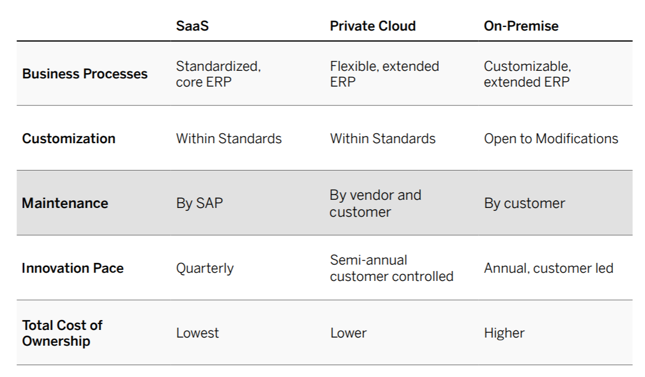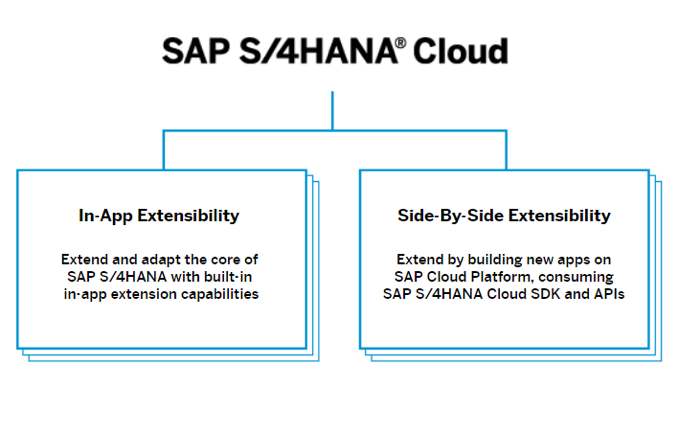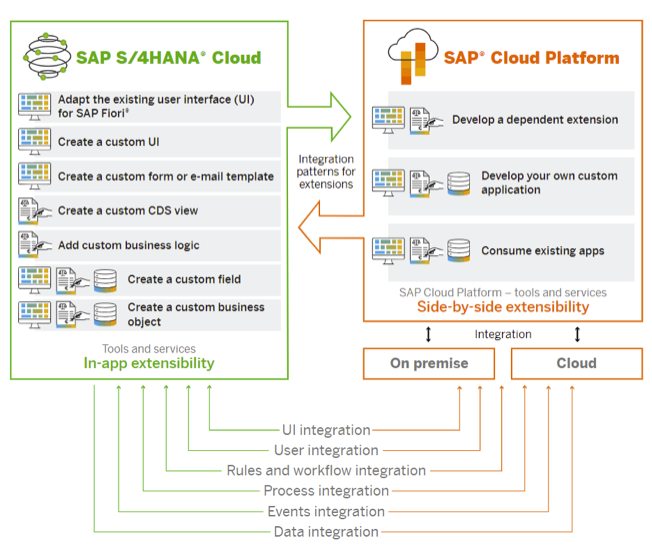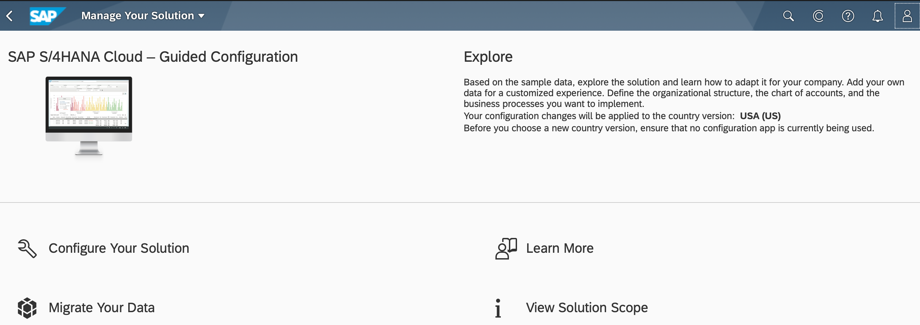SAP S/4HANA Cloud: 3 Key Deployment Considerations
By: Frank Ferris, Senior Consultant, TruQua
By now, those who work with SAP products have some level of familiarity with SAP S/4HANA, the latest business suite from SAP. As enterprise customers make a strategic push towards the cloud and software-as-a-service, it’s only natural that SAP has begun to offer this as a cloud-based solution.
Different customer scenarios, use cases, and business requirements will warrant detailed introspection of the various deployment options of SAP S/4HANA. This blog will focus on key takeaways and considerations related to SAP S/4HANA Cloud, Essentials Edition.
With the release of SAP S/4HANA Cloud, S/4HANA is now available in a variety of different deployment options to suit a given customer’s business case. These deployment options range from SAP S/4HANA on-premise for a highly customizable solution to S/4HANA Cloud, Essentials Edition for a highly standardized solution hosted on a shared (SAP managed) infrastructure. In addition, there are hybrid approaches that include deployment on a private infrastructure (hosted by SAP or one of the major cloud infrastructure providers) with SAP S/4HANA Cloud, Extended Edition and SAP S/4HANA Private Cloud on HANA Enterprise Cloud.

Figure 1: Move to the Cloud at Your Speed with SAP S/4HANA (Source: SAP)
What is SAP S/4HANA Cloud and how does it work?
SAP S/4HANA Cloud is SAP’S S/4HANA ERP in the Cloud with a suite of integrated and intelligent business applications. As SAP and its customers move toward creating the Intelligent Enterprise, the 3 pillars that define this approach and sit at the core of S/4HANA are:
- Automation: Intelligence and learning capabilities powered by artificial intelligence and predictive analytics
- Next-Generation Processes: Smart application of technology and innovation
- Digital Age User Experience: Standardized organization-wide user experience through the SAP Fiori concept.
These principles are further enhanced in S/4HANA Cloud via an SAP managed infrastructure, and the enablement of project teams and customers through the SAP Activate methodology. The SAP Activate Methodology consists of SAP Best Practice business processes and project accelerators. The end results are simple: the customer owns more aspects of the implementation including data migration, business process testing and organizational change management. This is a stark juxtaposition to SAP’s On-Premise SAP S/4HANA system and provides the following benefits for S/4HANA Cloud Customers.
- Faster ROI through more timely software deployments
- Increased business agility via SAP Best Practice business processes and SAP model company
- Lower TCO through an SAP managed infrastructure and BASIS functions
- Improved governance & compliance due to the standardized nature of the cloud-based SAP S/4HANA solution and its quarterly upgrade cycle
- A more intelligent ERP system that improves business efficiency through Fiori applications that leverage RPA, machine learning, and artificial intelligence
Now lets and expand on three key considerations that are pivotal to SAP S/4HANA Cloud, Essentials Edition.
1. SAP Activate and Business Process Standardization
Every SAP S/4HANA Cloud implementation has a heavy focus on SAP Activate, which is an agile methodology that provides a structure throughout the customer lifecycle. The SAP Activate methodology enables implementation teams and customers with how-to documents, project accelerators, questionnaires, templates and tools for organizational change management.

Figure 2: SAP S/4HANA Cloud Implementation with SAP Activate Methodology (Source: SAP)
SAP Best Practice business processes are also encompassed within the SAP Activate methodology. The Best Practice business processes provide a path to process standardization which is a cornerstone of SAP S/4HANA Cloud. Unlike on-premise deployments of SAP S/4HANA, the Prepare & Explore phases of the project stipulated that the implementation team conduct ‘Fit-to-Standard’ workshops rather than ‘Gap-Fit’ workshops. Furthermore, any deviations from the standard must be clearly discussed, documented and evaluated prior to implementation. This big push for standardization is rooted in the idea that customers should be able to quickly and painlessly utilize the latest updates and innovations to S/4HANA Cloud as they’re released by SAP in accordance with the quarterly upgrade cycle.
The SAP Activate methodology is so tightly coupled with S/4HANA Cloud implementations that the project phases determine what systems are provisioned to the customer.
- During the Prepare & Explore phases the Starter System is delivered SAP sample business process configuration, allowing customers to explore SAP Best Practice Business Processes through the Fit-to-Standard workshops.
- Prior to entering the Realize phase, the customer requests the Quality system (Q) where the system configuration and testing will occur.
- Once the Prepare & Explore phases are complete, the project enters the Realize phase and the Q system is delivered to the customer.
- During the Realize phase, system configuration begins in the Q system and leverages the project accelerators and templates that were completed in the Prepare & Explore phases.
- The Production system (P) is requested and delivered prior to exit from the Realize phase, allowing the transfer of the configuration from the Q system to the P system prior to system go-live in the Deploy phase.
- Lastly, the P system is where the customer will conduct their day-to-day business during the Run phase.
2. Managed Infrastructure and Extensibility Options in SAP S/4HANA Cloud
In addition to the push for the standardization of business processes via SAP Best Practices, there is also a push for the standardization of the technology platform. This leads to one of the key benefits of SAP S/4HANA Cloud, which is that both the infrastructure and BASIS functions (typically customer-managed) are managed by SAP. For example, the SAP S/4HANA Cloud Service Team manages moving change projects (transports) between the Q & P systems, applies the quarterly upgrades/patches to the system, and handles the activation of additional scope items to enable new business processes in the system. This ultimately results in less IT and administrative costs for the customer and a decrease in the number of technical consultants required for the system integration partner. With less of a burden on the implementation consultants to manage the infrastructure and BASIS functions, there is ample opportunity to optimize the customer experience by directing their focus towards the functional and business process configuration.
Another way that SAP intends to preserve the upgradeability of an SAP S/4HANA Cloud environment is by strongly encouraging the extension of the system rather than customization. Applying manual fixes to customizations on top of SAP delivered code after a system update is a thing of the past. Much like the theme of standardization of business processes to preserve configuration through the quarterly upgrade cycle, the same concept applies to the extensibility of the system. SAP provides multi-faceted, easy to use toolsets for stable life-cycle extensibility through in-app and side-by-side extensibility through SAP Cloud Platform and the SAP S/4HANA Cloud software development kit.

Figure 3: S/4HANA Cloud Extensibility Options (Source: SAP)
In-app extensibility refers to extensions made within S/4HANA Cloud to adapt standard functionality to meet end-user requirements and business needs. This can range from UI modifications to Fiori applications with custom fields, forms & templates to the creation of custom business logic, business objects, and CDS views. On the contrary, side-by-side extensibility refers to building new applications by using a combination of SAP Cloud Platform and the SAP S/4HANA Cloud SDK. Additionally, side-by-side extensibility can also refer to the native integration of other cloud-based SAP LoB Solutions as well as the integration of third-party applications via Whitelisted API’s.

Figure 4: SAP Cloud Platform Landscape and Integration (Source: SAP)
Whether a customer leverages in-app or side-by-side extensibility, SAP is able to provide tools for flexibility and integration, while remaining simple enough to not over encumber the system with customization.
3. Functionality Differences between On-Premise and the Cloud
Lastly, a few nuances that differentiate S/4HANA Cloud from its on-premise counterpart will be discussed. A large conceptual change from legacy SAP systems and SAP S/4HANA On-Premise is that there is no SAP GUI access in S/4HANA Cloud. Rather, all the configuration and day-to-day business transactions occur through the browser-based Fiori launchpad. One of the key Fiori applications used to better understand how S/4HANA Cloud is implemented and maintained is the Manage Your Solution App. Manage Your Solution contains multiple sub-applications including Configure Your Solution, Migrate Your Data (Data Migration Cockpit), View Solution Scope and Test Your Processes.

Figure 5: Manage Your Solution Screenshot from TruQua S/4HANA Cloud Partner tenant. (Source: SAP)
Configure Your Solution can be compared to transaction code SPRO where system configuration occurs in legacy SAP and S/4HANA On-Premise environments. Instead of navigating to different configuration points via nodes in the IMG path, SAP provides what are called Self-Service Configuration UI’s (SSCUI’s) for different bits of business process and technical configuration. The SSCUI’s provide guided configuration steps for the business processes and technical components that correlate with the activated scope items in a S/4HANA Cloud environment. The View Solution Scope sub-application allows the customer to browse what scope items are active or available to activate in their S/4HANA Cloud environment. The activation of scope items occurs by opening an incident with the S/4HANA Cloud service team on the One Support launchpad. The Migrate Your Data sub-application grants access to the data migration cockpit that is also found in an SAP S/4HANA On-Premise environment and shares the same functionality regarding creating change projects and downloading templates for importing/exporting data. Lastly, there is a Test Your Processes sub-application that facilitates automated testing of business processes. Test Your Processes allows the customer to automate business process configuration testing during initial implementation, after activation of new scope items, and after quarterly upgrades and patches are pushed to the system.
Conclusion:
SAP S/4HANA Cloud offers the power of an on-premise solution in that it can be the core of an organization’s technology platform while the nature of cloud deployment allows it to benefit from the constant innovation SAP delivers through the quarterly upgrade cycle. SAP S/4HANA Cloud’s emphasis on the SAP Activate methodology provides a pathway for implementation teams to better aid customers through the project life cycle and leverage SAP Best Practices to make improvements and standardizations to their legacy business processes. SAP managed infrastructure and administration functions reduce the total cost of the solution to the customer, while the toolsets SAP supports for extensibility grant the flexibility demanded by the modern enterprise. Though there are several functionality differences from SAP S/4HANA On-Premise, SAP S/4HANA Cloud’s Fiori interface provides a sleek, organization-wide user experience that is a welcome change from the SAP GUI.
About the Author:
 Frank Ferris is a certified SAP professional with 3.5 years of client-facing experience working with a variety of SAP products and technologies including SAP S/4HANA Cloud, SAP Analytics Cloud, SAP S/4HANA, SAP BPC, and SAP ECC. Frank has supported clients in the manufacturing, consumer packaged goods, and pharmaceuticals industries. Frank holds a certification in SAP S/4HANA Cloud – Finance implementation and is current up to the 2002 release.
Frank Ferris is a certified SAP professional with 3.5 years of client-facing experience working with a variety of SAP products and technologies including SAP S/4HANA Cloud, SAP Analytics Cloud, SAP S/4HANA, SAP BPC, and SAP ECC. Frank has supported clients in the manufacturing, consumer packaged goods, and pharmaceuticals industries. Frank holds a certification in SAP S/4HANA Cloud – Finance implementation and is current up to the 2002 release.
Thank you for reading this installment in our S/4HANA Cloud blog series. Stay tuned for our next post where Consultant Andrew Xue will discuss how S/4HANA Cloud Integrates with other SAP Applications. For more information on S/4HANA Cloud or TruQua’s services and offerings, visit us online at www.truqua.com. To be notified of future blog posts and be included on our email list, please complete the form below.
Works Cited:
- SAP Whitepaper, Move to the Cloud at your speed with SAP S/4HANA – file:///C:/Users/fferris/Downloads/Move%20to%20the%20Cloud%20at%20Your%20Speed%20with%20SAP%20S_4HANA.pdf
- SAP S/4HANA Cloud Implementation with SAP Activate https://support.sap.com/content/dam/SAAP/SAP_Activate/S4H_188%20SAP%20S4HANA%20Coud%20Implementation%20with%20SAP%20Activate.pdf
- Extensibility Graphic – https://blogs.sap.com/2019/01/29/sap-extensibility-explorer-for-sap-s4hana-cloud-httpswww.sap.comextends4/
- SAP Cloud Platform Landscape and Integration – https://www.sap.com/documents/2015/07/2ad59b27-347c-0010-82c7-eda71af511fa.html
- Manage Your Solution Screenshot from TruQua S/4HANA Cloud partner tenant.
